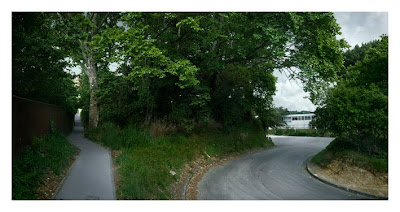
A new public artwork launched in Wellington tomorrow (Tuesday 30 November) challenges viewers to think about history and the often forgotten stories hidden in the landscapes that surround us.
Wellington artist Ann Shelton has been selected to create the first artwork for the Ghuznee Street Art Billboard project and her work engages directly with Wellington’s early history.
The work titled Capital, execution site, formerly The Terrace Gaol, The Terrace, Te Aro, Wellington is a recent photograph of what was once the gaol site. However, those who recognise the spot will realise that it is not a straight depiction and Shelton’s reversal of the image immediately raises questions and complicates its interpretation.
Supported by the Creative Communities Wellington Local Funding Scheme and Bartley + Company Art, the billboard projected has been established to give artists an opportunity to work at a large scale and to intervene in the predominantly commercial nature of the city’s visual culture.
Alison Bartley of Bartley + Company Art says there was a great response to the call for proposals from local artists who seem excited by the project. The funding covers three art billboards and three artists have been selected with each art billboard to be up for three months. With many very strong proposals the selection panel (comprising Bartley, Te Papa’s senior curator and a representative from City Arts) had a challenging task selecting three finalists. The other artists will be announced when their projects are installed in March and June 2011.
Ann Shelton says she is pleased to have the opportunity to communicate to an urban public in addition to the specific art audience who visit galleries. She has written about her work:
The image depicts the approximate space where executions occured in Wellington in the 19th century. The image, printed in reverse (a mirror image), reactivates the public memory of Wellington and re-scripts the moral and ethical narratives that we take for granted in/about our city. This work provides a context for the reevaluation of city space, its social and juridical uses.
Now close of the recreational and educational areas of Victoria University and Te Aro School the site around which the executions occured reflects Walter Benjamin’s famous statement that ‘every site is the scene of a crime’, in this case acts of great violence. This artwork raises complex questions regarding the relationships between land use, history, trauma, ethics and crime as they circulate in relation to Wellington City. Crucially, these apsects of our city’s history are largely unknown and complicate the narratives of urban pride and positivity that are at large in our city culture. Argueing for a city more cogniscant of its chequered past and one that remembers its failures, this work attempts to activate discourse via the potential of photography’s testimonial ability.
My ongoing research investigates how events are displaced in the landscape, what that means and how an examination of these events can affect contemporary knowledge. I am interested in these histories not as a nostalgic look back to the past nor as a goulish infatuation with it, but as a way to critically negotiate the meta discourses that are at work in the mechanisims of these events. My images ask what is remembered, what is recorded and reiterated – "If memory is reflection then Shelton’s images are about the anxiety of what is able to be really known and kept."[1]
Ann Shelton is an artist and Senior Lecturer at Massey University School of Fine Arts, Wellington. She has exibited widely both in New Zealand and overseas and her work is in numerous local and international collections. Earlier this year she won the COCA Anthony Harper Contemporary Art Award and in 2006 the Trust Waikato Contemporary Art Award.
1. Word reaches Us From The Distance, Huddleston, Charlotte, a kind of sleep, the Govett-Brewster Art Gallery. 2006 p.26.



